Biden’s ‘diversity and inclusion’ gone wild
Department of State announces appointment of 'Chief Diversity and Inclusion Officer'
Secretary of State Anthony Blinken announced the creation of a Chief Diversity and Inclusion Officer (CDIO), saying, in a statement, that “diversity and inclusion make us stronger, smarter, more creative, and more innovative.” Advocates of such move point out that a Government Accountability Office report found that “ethnic minorities are still underrepresented,” at the State Department, “particularly in the senior ranks.”
The report found that in 2018, 68 percent of the department’s workforce was White, 15 percent African American, seven percent Hispanic and six percent Asian American. Seniority aside, when comparing the report’s percentages to ethnicity percentages of the Census Bureau, the composition of the State Department’s workforce looks in favor of African Americans, at the expense of Whites and Hispanics.
Per the bureau, Whites form 76 percent of the US population, yet only 68 percent at State are White. Similarly, Hispanics account for 18.5 percent of Americans, but only form six percent at the department. The only fairly represented ethnicity are Asians, who form six percent of the US population and six percent of the State Department’s workforce.
In fact, if one takes the Census Bureau’s ethnic demographics as reference to how representation should be at the different industries, things will not look bright for America’s White population.
Consider that out of America’s one million physicians, only 56 percent are White (instead of 76 percent). Among Physicians, Asian Americans are over represented, at 17 percent, compared to their six percent of the population, while Hispanics are — again — underrepresented at only six percent of physicians, clearly not reflecting their 18.5 percent of the US population. African American Physicians are also underrepresented at five percent, but their way to fair representation, up to 13 percent, is shorter than that of Whites and Hispanics.
Apply this same methodology to the tech sector, where Asian Americans are way overrepresented at 39 percent, compared to 53 percent of Whites, three percent Hispanic and one percent African American. To make the tech industry more “diverse and inclusive,” giant tech companies should recruit more Whites, Hispanics and African Americans, and less Asian Americans.
So unlike the story line that is often peddled in the media, the percentage of ethnic groups in government and at various US sectors is not binary White vs Black, but rather multi-ethnic. Neither Whites are overrepresented everywhere, as is the common wisdom, nor minorities are underrepresented. Some professions and sectors have more representation of some ethnic group or another, yet this is not due to the “Critical Race Theory,” but more due to economic and cultural factors within each group.
Asian American affinity to Science, Technology, Engineering and Math (STEM) is evident, and even though a minority, Asian Americans have succeeded to beat the “privileged” Whites, often by a mile, at some sectors with the highest paying jobs in the land.
The Asian American experience shows that breaking through is possible for hard workers, as long as the system is based on merit. When “affirmative action” and “diversity and inclusion” become the decisive factors, talent loses to politics.
As a foreign policy practitioner, I know firsthand what it takes to succeed in Foreign Service. In addition to the basic skills taught at academic institutions, diplomats have to be curious enough to live — during their study years — in faraway lands, learn and become fluent in foreign languages, and immerse themselves in foreign cultures to understand how other nations and their governments work. Merit should be the yardstick for who becomes US ambassador anywhere, not the color of their skin.
If America persists with its “diversity and inclusion” madness, it will soon resemble the two countries where I grew up — Lebanon and Iraq — where ethnic quotas are strictly implemented, and where governments have never been a success to emulate.




Well said